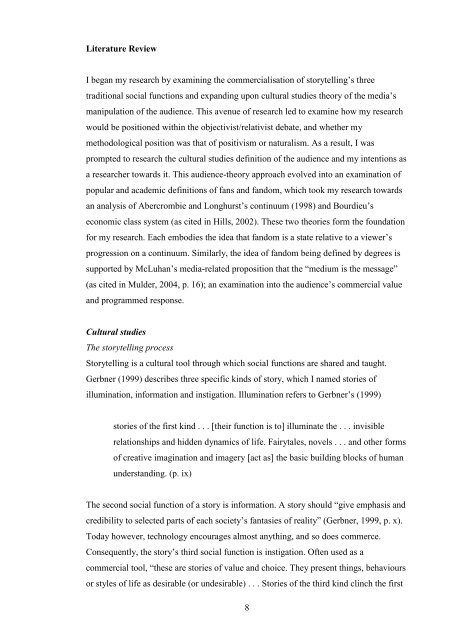The Case Study of Sherlock Holmes (2009) - Scholarly Commons ...
The Case Study of Sherlock Holmes (2009) - Scholarly Commons ...
The Case Study of Sherlock Holmes (2009) - Scholarly Commons ...
You also want an ePaper? Increase the reach of your titles
YUMPU automatically turns print PDFs into web optimized ePapers that Google loves.
Literature Review<br />
I began my research by examining the commercialisation <strong>of</strong> storytelling‟s three<br />
traditional social functions and expanding upon cultural studies theory <strong>of</strong> the media‟s<br />
manipulation <strong>of</strong> the audience. This avenue <strong>of</strong> research led to examine how my research<br />
would be positioned within the objectivist/relativist debate, and whether my<br />
methodological position was that <strong>of</strong> positivism or naturalism. As a result, I was<br />
prompted to research the cultural studies definition <strong>of</strong> the audience and my intentions as<br />
a researcher towards it. This audience-theory approach evolved into an examination <strong>of</strong><br />
popular and academic definitions <strong>of</strong> fans and fandom, which took my research towards<br />
an analysis <strong>of</strong> Abercrombie and Longhurst‟s continuum (1998) and Bourdieu‟s<br />
economic class system (as cited in Hills, 2002). <strong>The</strong>se two theories form the foundation<br />
for my research. Each embodies the idea that fandom is a state relative to a viewer‟s<br />
progression on a continuum. Similarly, the idea <strong>of</strong> fandom being defined by degrees is<br />
supported by McLuhan‟s media-related proposition that the “medium is the message”<br />
(as cited in Mulder, 2004, p. 16); an examination into the audience‟s commercial value<br />
and programmed response.<br />
Cultural studies<br />
<strong>The</strong> storytelling process<br />
Storytelling is a cultural tool through which social functions are shared and taught.<br />
Gerbner (1999) describes three specific kinds <strong>of</strong> story, which I named stories <strong>of</strong><br />
illumination, information and instigation. Illumination refers to Gerbner‟s (1999)<br />
stories <strong>of</strong> the first kind . . . [their function is to] illuminate the . . . invisible<br />
relationships and hidden dynamics <strong>of</strong> life. Fairytales, novels . . . and other forms<br />
<strong>of</strong> creative imagination and imagery [act as] the basic building blocks <strong>of</strong> human<br />
understanding. (p. ix)<br />
<strong>The</strong> second social function <strong>of</strong> a story is information. A story should “give emphasis and<br />
credibility to selected parts <strong>of</strong> each society‟s fantasies <strong>of</strong> reality” (Gerbner, 1999, p. x).<br />
Today however, technology encourages almost anything, and so does commerce.<br />
Consequently, the story‟s third social function is instigation. Often used as a<br />
commercial tool, “these are stories <strong>of</strong> value and choice. <strong>The</strong>y present things, behaviours<br />
or styles <strong>of</strong> life as desirable (or undesirable) . . . Stories <strong>of</strong> the third kind clinch the first<br />
8

















